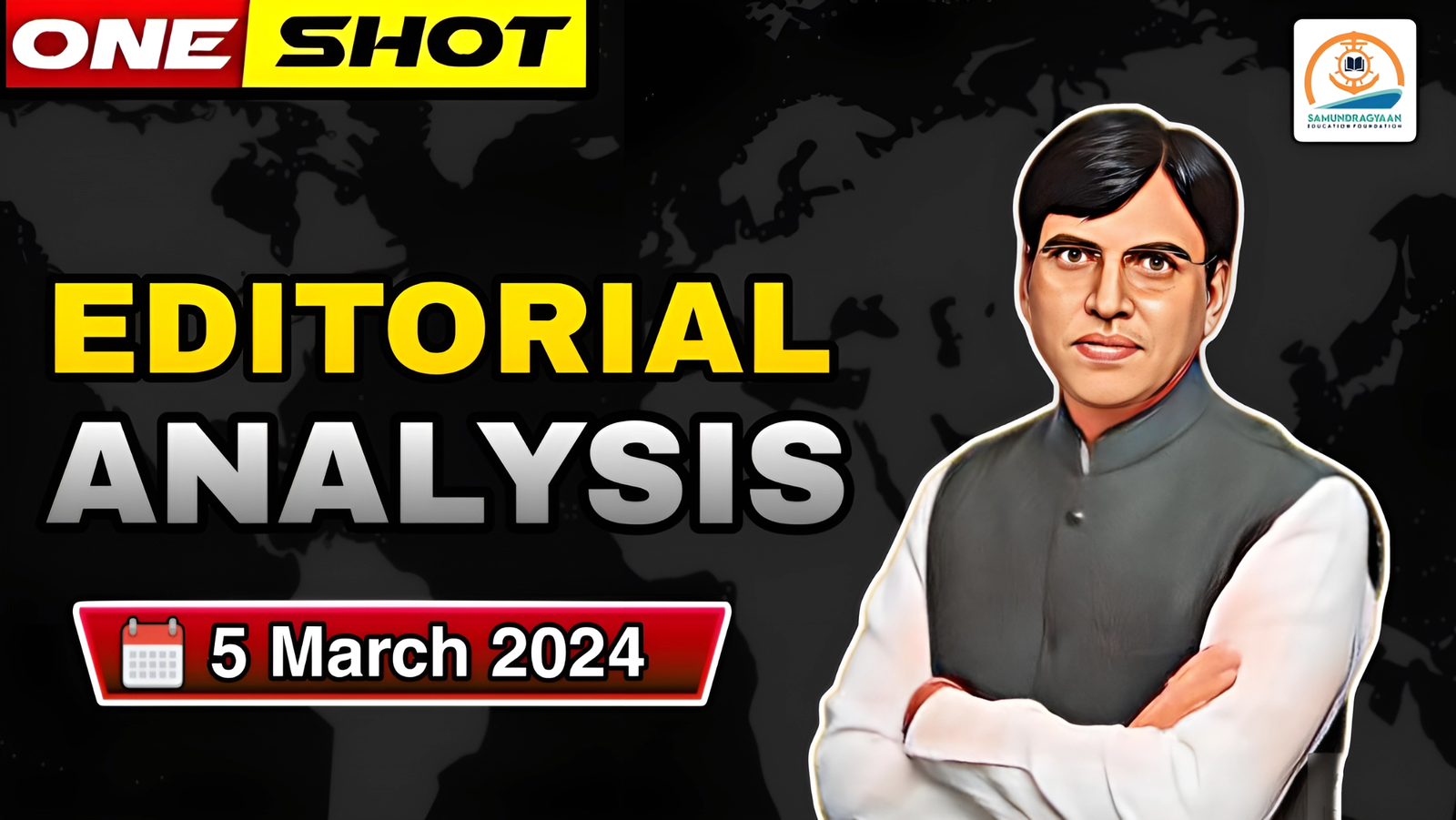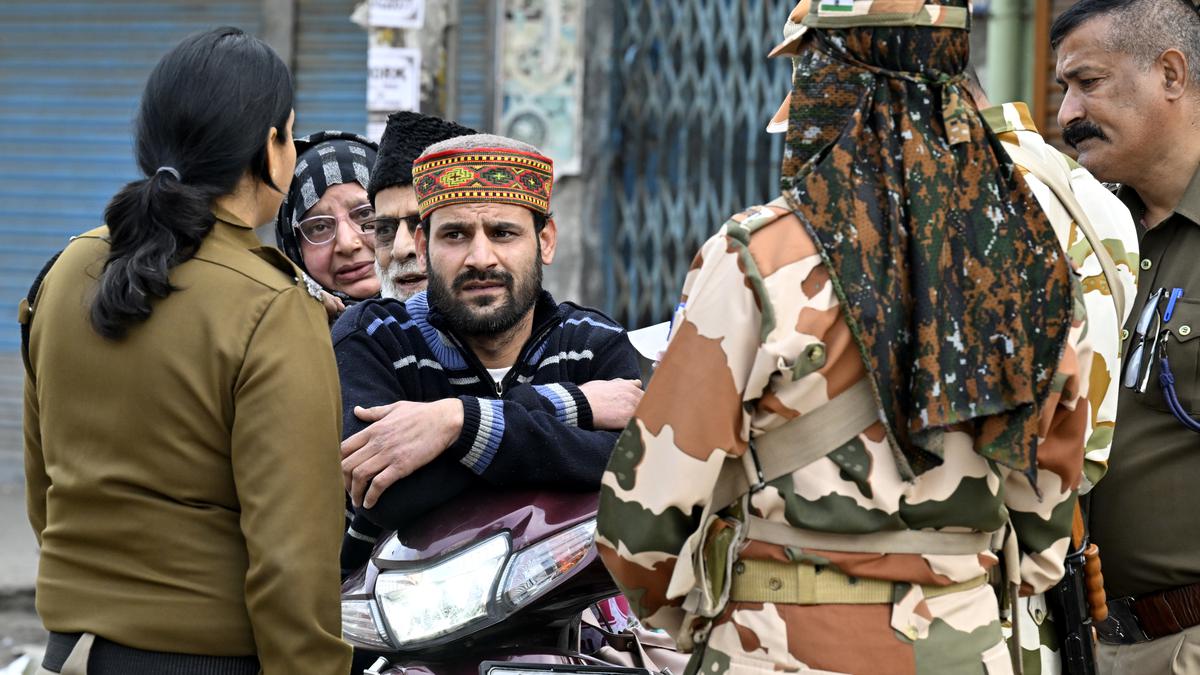Why in news?
- A seven-judge Constitution Bench of the Supreme Court said that Members of Parliament and state legislatures who take bribes to vote or speak in a certain manner in the House are not immune from prosecution.
- With this judgement, the apex court has overruled its 1998 judgment (JMM bribery case) which granted immunity to such lawmakers.
What’s in today’s article?
- Privileges and Immunities to the MPs and MLAs
- Background of the present case
- News Summary
Privileges and Immunities to the MPs and MLAs:
- Meaning: Privileges are special rights, immunities and exemptions enjoyed by the two Houses of Parliament and legislature of States, and their committees and their members.
- The Constitution has also extended these privileges to those persons who are entitled to speak and take part in the proceedings of a House or any of its committees.
- For example, the Attorney General of India.
- Constitutional provisions: Article 105 and Article 194 to the Constitution of India grant privileges or advantages to the MPs (Article 105) and to the MLAs (Article 194) of every State.
- These powers, privileges and immunities should be defined by the law from time-to-time.
- These privileges are considered as special provisions and have an overriding effect in conflict.
- It must be clarified here that these privileges do not extend to the President (or Governor) who is also an integral part of the Parliament (or state legislature).
- Privileges mentioned in the Constitution:
- It gives the MPs freedom of speech [Article 115 (1)].
- It provides that no MP will be liable to any proceedings before any Court for anything said or any vote given by him/her in the Parliament or any committee thereof [Article 105(2)].
- Also, no person will be held liable for any publication of any report, paper, votes or proceedings if the publication is made by the parliament or any authority under it.
- The same provisions are stated under Article 194, where MLAs of a state are referred instead of MPs.
- Purpose: These privileges and immunities –
- Are granted so that MPs/MLAs can perform their duties or can function properly without any hindrances – essential for democratic functioning of the legislatures.
- Without these privileges,
- The Houses can neither maintain their authority, dignity and honour.
- Nor can protect their members from any obstruction in the discharge of their parliamentary responsibilities.
- Difference between Article 19 and Article 105:
- Both the Articles, (Article 19(1)(a) and Article 105) of the Constitution talks about freedom of speech.
- Article 105 applies to the members of parliament not subjected to any reasonable restriction. But, Article 19(1)(a) applies to citizens and is subject to reasonable restrictions.
- This means, Article 105 is an absolute privilege given to the members of the parliament but this privilege can be used in the premises of the parliament and not outside the parliament.
Background of the present case
- 1998 P.V. Narsimha Rao Case
-
- In 1993, Jharkhand Mukti Morcha (JMM) leader Shibu Soren and some of his party MPs were accused of taking bribes to vote against the no-confidence motion against the then P V Narasimha Rao government.
- The apex court (by a 3:2 majority) granted immunity from prosecution to MPs who took bribes and voted to save the then Congress government in Parliament.
- The SC held that legislators enjoy immunity from criminal prosecution for bribery in matters connected to their speech and votes in Parliament and Legislative Assemblies.
- Matter reached Supreme Court again
- An MLA from the JMM, Sita Soren, was accused of accepting a bribe in return for her vote for a candidate during the 2012 Rajya Sabha elections.
- She moved the Jharkhand HC for quashing the chargesheet and criminal proceedings against her, relying on the provisions of Article 194 (2), but the HC had declined to do so.
- As a result, she appealed in the Supreme Court
- 1998 Judgement referred to larger bench
- In March 2019, SC observed that the decision in P.V. Narasimha dealt directly with such cases.
- However, the bench took note of the fact that the case was decided by a narrow margin (a 3:2 split among the five judges) and stated that the issue was a matter of substantial public importance.
- As a result, they referred the matter to a larger bench.
- In September 2023, a five-judge bench led by CJI Chandrachud demarcated three issues that needed to be reconsidered from the case and referred the case to a seven-judge bench.
News Summary: Bribes for votes case
Key highlights of the current judgement
- No immunity on the charges of accepting bribe
- An individual member of the legislature cannot assert a claim of privilege to seek immunity under Articles 105 and 194 from prosecution on a charge of bribery in connection with a vote or speech in the legislature.
- Accepting bribes do not pertain to the duties of lawmakers
- Accepting a bribe is a separate crime that is not linked to the actions or words of a lawmaker within the Parliament or legislative assembly.
- Therefore, the immunity provided under Articles 105 and 194 does not extend to cases of bribery, as these do not pertain to the duties of lawmakers.
- Threat to the functioning of Indian parliamentary democracy
- The court cautioned that granting such protection would create a group of individuals who enjoy unregulated exemption from the law.
- It emphasized that corruption and bribery by legislators have the potential to undermine the functioning of Indian parliamentary democracy.
- Such a claim to immunity fails to fulfill the two-fold test:
- that the claim is tethered to the collective functioning of the House and
- that it is necessary to the discharge of the essential duties of a legislator.
- On the question of when the offence of bribery is considered as complete
- The court stated that the bribery is considered complete once the offer or agreement to bribe is made, regardless of whether the vote is cast in the agreed direction or if the vote is cast at all.
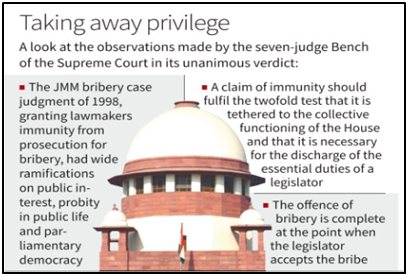
Need for Reforming Bail Laws in India
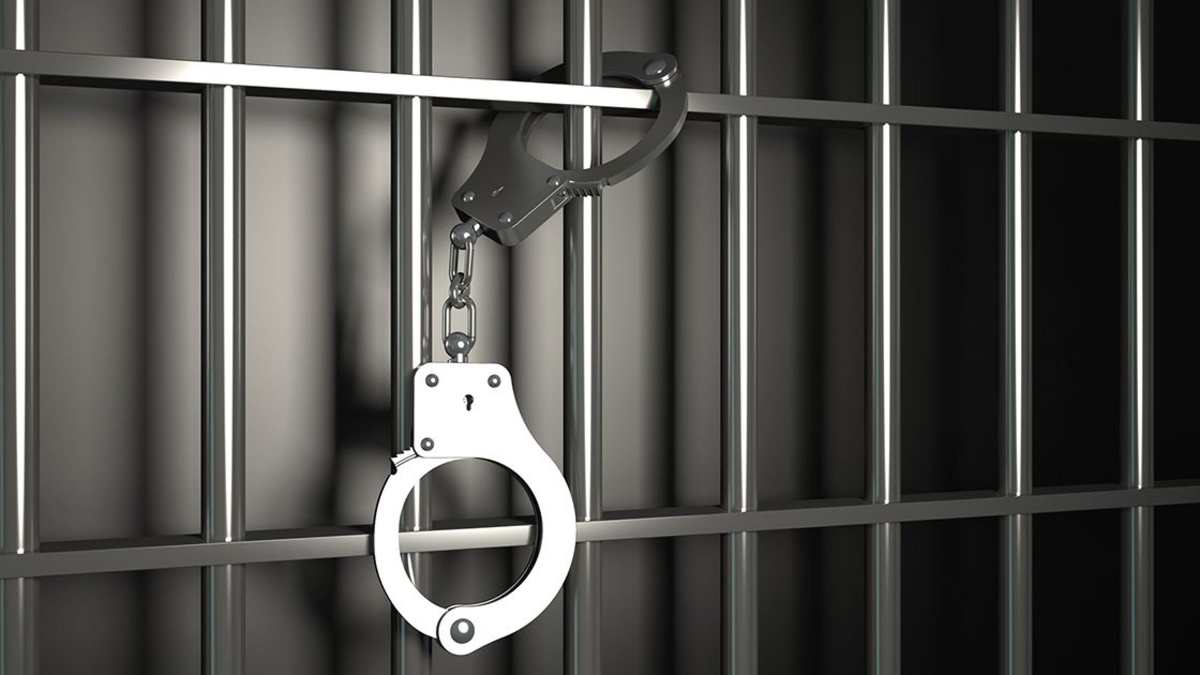
What’s in Today’s Article?
- Background
- About Bail (Definition, Types of Bail, Cancellation of Bail)
- Challenges in Bail Compliance
- Way Ahead
Background:
- Over 75% of India’s prison population are undertrials while overcrowding in Indian prisons stands at 118%.
- The Supreme Court of India recently acknowledged, in Satender Kumar Antil vs CBI, the ineffectiveness of India’s bail system and its contribution to this crisis.
- The Court noted that despite repeated guidelines on bail law, things have not changed much on the ground.
- The Court provided comprehensive guidelines on laws related to bail.
- This includes mandating timelines for the disposal of bail applications and laying emphasis on the need to enact a separate legislation.
- The judgment noted that crowding jails with undertrial prisoners ignored the principle of ‘presumption of innocence’ and that ‘bail not jail’ should be the norm.
- However, there is still a need to reflect on why these established principles are honored more in their breach than observance.
What is ‘Bail’?
- Bail refers to the provisional release of the accused in a criminal case in which the court is yet to announce the judgment.
- The term ‘bail’ means the security that is deposited in order to secure the release of the accused.
Types of Bail in India:
- The CrPC does not define the word bail.
- The Code of Criminal Procedure (CrPC) was first drafted in 1882 and continues to be in use with amendments from time to time.
- Depending upon the stage of the criminal matter, there are commonly three types of bail in India:
- Regular Bail:
- A regular bail is generally granted to a person who has been arrested or is in police custody.
- A bail application can be filed for the regular bail under section 437 and 439 of CrPC.
- Interim Bail:
- This type of bail is granted for a short period of time and it is granted before the hearing for the grant of regular bail or anticipatory bail.
- Anticipatory Bail:
- Anticipatory bail is granted under section 438 of CrPC either by session court or High Court.
- An application for the grant of anticipatory bail can be filed by the person who discerns that he may be arrested by the police for a non- bailable offence.
Conditions for Grant of Bail in Bailable/Non-Bailable Offences:
- Conditions for bail in bailable offence are:
- There are sufficient reasons to believe that the accused has not committed the offence.
- There is sufficient reason to conduct further enquiry in the matter.
- The person is not accused of any offence punishable with death, life imprisonment or imprisonment up to 10 years.
- Conditions for grant of bail in non-bailable offences:
- If the accused is a woman or a child, bail can be granted in a non-bailable offence.
- If there is lack of evidence then bail in non-Bailable offences can be granted.
- If there is delay in lodging FIR by the complainant, bail may be granted.
- If the accused is gravely sick.
Cancellation of Bail:
- Court has the power to cancel the bail even at a later stage.
- The Court can cancel the bail granted by it and give directions to the police officer to arrest the person and keep in police custody.
Challenges in Bail Compliance:
- A large number of undertrials continue to remain in prison despite being granted bail due to challenges in complying with bail conditions.
- Lack of means to arrange for money/property and local sureties are the most significant reasons accounting for an undertrial’s inability to comply with bail conditions.
- Factors such as lack of residence and identity proof, abandonment by family and limitations in navigating the court system also undermine an undertrial’s ability to comply with bail conditions.
- Compliance with bail conditions and ensuring presence in courts for the overwhelmingly structurally disadvantaged undertrials requires constant handholding.
- This is a crucial aspect of ensuring last mile delivery of justice that the extant bail law does not consider.
- Data shows that in 14% of cases, undertrials were unable to comply with bail conditions and remained in prison despite being granted bail.
- In almost 35% of these cases, it took over a month after obtaining the bail for undertrials to comply with bail conditions and secure their release.
Flawed Assumptions:
- The bail system, as it currently operates, has flawed assumptions that every arrested person will be propertied or have access to propertied social connections.
- It presumes that the risk of financial loss is necessary to ensure the presence of the accused in court.
- Such assumptions have the effect of rendering the rule of ‘bail not jail’ meaningless for a significant proportion of undertrial persons.
- For any bail law to effectively provide relief, a careful re-evaluation of the said presumptions is imperative.
- There is an urgent need for bail reform but it would be counterproductive to undertake a reform exercise without first developing the empirical basis to understand and diagnose the problem at hand.
Way Ahead:
- In July 2022, the Supreme Court had issued guidelines to the line on certain procedural issues for the police and judiciary. These guidelines are:
- Separate Law for Bail:
- Currently, the Bail Act of the United Kingdom, 1976, prescribes the procedure for granting bail.
- The court underlined that the CrPC, despite amendments since Independence, largely retains its original structure as drafted by a colonial power over its subjects.
- The court’s solution on this is the framing of a separate law that deals with the grant of bail.
- Indiscriminate Arrests:
- The court noted that the culture of too many arrests, especially for non-cognisable offences, is unwarranted.
- It emphasised that even for cognisable offences, arrest is not mandatory and must be “necessitated”.
- Bail Application:
- “There need not be any insistence of a bail application while considering the application under Section 88, 170, 204 and 209 of the Code,” the court held.
- These sections relate to various stages of a trial where a magistrate can decide on release of an accused.
- The Supreme Court held that in these circumstances, magistrates must routinely consider granting bail, without insisting on a separate bail application.
- Direction to States:
- The SC also directed all state governments and Union Territories to facilitate standing orders to comply with the orders and avoid indiscriminate arrests.
- The CBI has already communicated earlier orders of the Court to special judges under its jurisdiction.
Super Tuesday – a key day in the US Presidential elections

Why in news?
- March 5, 2024, is going to be a Super Tuesday in the ongoing cycle of the US Presidential elections, scheduled for November.
- On this day, supporters of the Democratic and Republican candidates in 15 states will vote for their preferred party candidate in the presidential race.
What’s in today’s article?
- How US elections work?
- What is a Super Tuesday?
How US elections work?
- Primaries and Caucuses
- American voters usually have a strong affiliation with either of the two major political parties.
- As part of the Presidential elections, they first vote in the primary and caucus polls, or in a third setup that is a combination of the two.
- In some of these, only registered Democrats or Republicans can vote, instead of general voters.
- In primaries, voters go to polling stations and check the box against the name of their favoured candidate.
- For example, Republican voters will have Donald Trump and Nikki Haley as their options, since other candidates have dropped out of the race.
- In comparison, caucuses are lengthier. Voters attend meetings at public places such as school gymnasiums, churches, and community centres, debate candidate preferences and openly raise their hands for their choice of vote.
- National Conventions of Each Party
- After the primaries and caucuses are over, a national convention is held in which a party’s nomination for president is formally announced to the public.
- During the convention, the elected delegates cast their vote for a party candidate and the candidate with the most delegates gets the party’s nomination.
- Significance of primary or caucus
- For candidates, winning a primary or caucus means winning the support of the several delegates that are assigned to each state.
- Delegates are the parties’ members or local supporters of a candidate.
- At this stage, delegates matter because it is they who later vote to select the party nominee at the Democratic and Republican National Conventions held in the summer.
- If no candidate gets the majority of a party’s delegates during the primaries and caucuses, convention delegates vote to choose the nominee.
- Delegates are seen as representing the party’s will, although some have criticised the process for not letting voters directly choose their candidate.
What is a Super Tuesday?
- Super Tuesday is the day when the largest number of states hold their presidential primaries and caucuses.
- Those state-level races help candidates from the two major political groups — the Democrats and the Republicans — gather the delegates they need to earn their party’s nods.
- Based on the result of each contest, party officials known as delegates are awarded to the top candidates.
- A certain number of delegates is needed to formally appoint the nominee at each party’s convention this summer.
- Delegates ultimately represent their states at a party convention, where they cast votes for the nominee based on the primary and caucus results.
India’s 3-Stage Nuclear Program

Why in News?
- Recently, the Indian PM witnessed the start of the process of core-loading the indigenous prototype fast breeder reactor (PFBR) at the Madras Atomic Power Station in Kalpakkam, Tamil Nadu.
- This is a historic milestone, marking entry into the vital second stage of India’s three stage nuclear program.
What’s in Today’s Article?
- India’s 3-Stage Nuclear Program
- Understanding the 3-Stages of India’s Nuclear Program
- How does the PFBR (Stage II) Work?
- Why was the PFBR (Stage II) Delayed?
- Challenges Ahead for the Stage II of India’s Nuclear Program
India’s 3-Stage Nuclear Program:
- India’s three-stage nuclear power programme was formulated by the well-known physicist Homi Bhabha in the 1950s –
- To achieve country’s long term energy security, independence and sustainable development,
- Through the use of uranium and vast thorium reserves.
- The three stages are:
- Natural uranium fuelled Pressurised Heavy Water Reactors (PHWRs)
- Fast Breeder Reactors (FBRs) utilising plutonium-based fuel
- Advanced nuclear power systems for utilisation of thorium
- Thorium is particularly attractive for India, as India has only around 1–2% of the global uranium reserves, but one of the largest shares of global thorium reserves (~25%).
- However, thorium is more difficult to use than uranium as a fuel because it requires breeding, and global uranium prices remain low enough that breeding is not cost effective.
- The Department of Atomic Energy (DAE) is carrying out indigenous R&D activities for development of Advanced Nuclear Power systems in line with the 3-stage nuclear power program.
- The three stages are expected to allow the country complete self-sufficiency in nuclear energy.
Understanding the 3-Stages of India’s Nuclear Program:
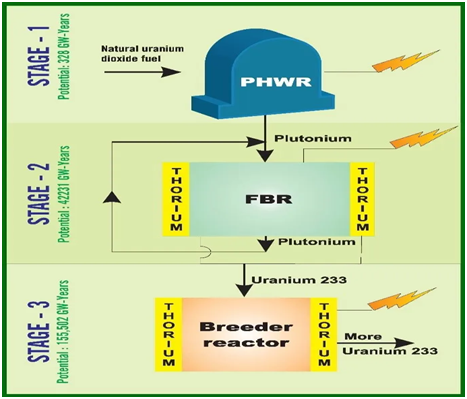
- In the first, India used PHWRs and natural uranium-238 (U-238), which contains minuscule amounts of U-235, as the fissile material.
- The heavy water in PHWR – water molecules containing the deuterium isotope of hydrogen – slows neutrons released by one fission reaction.
- The heavy water is pressurised to prevent it from boiling. The reactions produce plutonium-239 (Pu-239) and energy.
- Only U-235, not U-238, can sustain a chain reaction but it is consumed fully in stage I.
- In stage II, India will use Pu-239 together with U-238 in the PFBR to produce energy, U-233 and more Pu-239.
- The DAE set up a special-purpose vehicle in 2003 called Bharatiya Nabhikiya Vidyut Nigam, Ltd. (BHAVINI) to implement stage II.
- In stage III, Pu-239 will be combined with thorium-232 (Th-232) in reactors to produce energy and U-233.
How does the PFBR (Stage II) Work?
- A breeder reactor is a nuclear reactor that produces more fissile material than it consumes.
- In a ‘fast’ breeder reactor, the neutrons aren’t slowed, allowing them to trigger specific fission reactions.
- PHWRs use natural or low-enriched U-238 as the fissile material and produce Pu-239 as a byproduct.
- This Pu-239 is combined with more U-238 into a mixed oxide and loaded into the core of a new reactor together with a blanket.
- This is the material with which the core’s fission products react to make more Pu-239.
- It uses liquid sodium, a highly reactive substance, as coolant in two circuits.
- Coolant in the first circuit enters the reactor and leaves with (heat) energy and radioactivity.
- Via heat-exchangers, it transfers only the heat to the coolant in a secondary circuit.
- The latter transfers the heat to generators to produce electricity.
- The use of Throium-232, which in itself is not a fissile material, as a blanket is also envisaged in this stage.
- By transmutation, Thorium will create fissile Uranium-233 which will be used as fuel in the third stage.
- FBR is thus a stepping stone for the third stage of the program paving the way for the eventual full utilization of India’s abundant thorium reserves.
- The PFBR has a capacity of 500 MWe. In 2019, the DAE proposed building 4 more FBRs of 600 MWe capacity each – two in Kalpakkam from 2021 and two from 2025, with sites to be selected.
Why was the PFBR (Stage II) Delayed?
- The fast breeder test reactor (FBTR) at Kalpakkam is a testing ground for PFBR technologies.
- It was built by 1977 but sanctions against India’s ‘Smiling Buddha’ nuclear test forced the use of a mixed carbide fuel over enriched uranium (which France was to deliver).
- The former lowered the power output and changed operating conditions.
- By the time the Indian government started the PFBR in 2003, most people who worked on the FBTR were also nearing or had completed retirement.
- In a 2014 audit, the CAG discovered that BHAVINI had improperly handled the purchase of several PFBR components by becoming overly reliant on the NPCIL.
- Other causes of delay included technical difficulties with the reactor coolant.
- As a result, the cost of PFBR had ballooned to Rs 6,800 crore (by 2019) after multiple extensions of the deadline.
- The Indira Gandhi Centre for Atomic Research (IGCAR, Kalpakkam) designed the PFBR and the original cost was Rs 3,492 crore and the original deadline was 2010.
Challenges Ahead for the Stage II of India’s Nuclear Program:
- FBRs are harder to handle than other reactor designs.
- The thorium fuel cycle produces caesium-137, actinium-227, radium-224, radium-228, and thorium-230, which are all radioactive in ways that complicate their handling and storage.
- In 2015, the International Atomic Energy Agency (IAEA) urged India to set up an independent statutory atomic regulator instead.
- The DAE had responded with the Nuclear Safety Regulatory Authority (NSRA) Bill, which sought to replace the Atomic Energy Regulatory Body (AERB) with the NSRA.
- But it was criticised for allowing the Union government too much control over the NSRA’s composition.
- Today, the tariff for solar electricity is under Rs 2.5/kWh whereas nuclear electricity costs around Rs 4/kWh.
- The 2011 Fukushima Daiichi disaster also shifted public opinion worldwide against nuclear power, slowing work on new facilities.
- However, nuclear power has a new lease on lifeas a result of India’s pressure to decarbonise, cut its fossil fuel imports, and give its renewables sector some breathing space.
- In 2023, NPCIL stated that it expects to “commission a nuclear power reactor every year” beginning in 2024.

